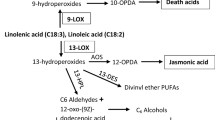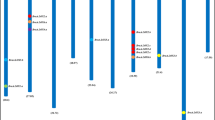Abstract
Lipoxygenases (LOXs) catalyze hydroperoxidation of polyunsaturated fatty acids (PUFAs) to form structurally and functionally diverse oxylipins. Precise physiological and biochemical functions of individual members of plant multigene LOX families are largely unknown. Herein we report on molecular and biochemical characterization of two closely related maize 9-lipoxygenase paralogs, ZmLOX4 and ZmLOX5. Recombinant ZmLOX5 protein displayed clear 9-LOX regio-specificity at both neutral and slightly alkaline pH. The genes were differentially expressed in various maize organs and tissues as well as in response to diverse stress treatments. The transcripts of ZmLOX4 accumulated predominantly in roots and shoot apical meristem, whereas ZmLOX5 was expressed in most tested aboveground organs. Both genes were not expressed in untreated leaves, but displayed differential induction by defense-related hormones. While ZmLOX4 was only induced by jasmonic acid (JA), the transcripts of ZmLOX5 were increased in response to JA and salicylic acid treatments. ZmLOX5 was transiently induced both locally and systemically by wounding, which was accompanied by increased levels of 9-oxylipins, and fall armyworm herbivory, suggesting a putative role for this gene in defense against insects. Surprisingly, despite of moderate JA- and wound-inducibility of ZmLOX4, the gene was not responsive to insect herbivory. These results suggest that the two genes may have distinct roles in maize adaptation to diverse biotic and abiotic stresses. Both paralogs were similarly induced by virulent and avirulent strains of the fungal leaf pathogen Cochliobolus carbonum. Putative physiological roles for the two genes are discussed in the context of their biochemical and molecular properties.







Similar content being viewed by others
Abbreviations
- ABA:
-
Abscisic acid
- AOS:
-
Allene oxide synthase
- GLV:
-
Green leaf volatiles
- HOD:
-
Hydroxy octadecadienoic acid
- HPL:
-
Hydroperoxide lyase
- HPOD:
-
Hydroperoxy octadecadienoic acid
- JA:
-
Jasmonic acid
- JA-Ile:
-
Jasmonic acid-isoleucine
- LOX:
-
Lipoxygenase
- MeJA:
-
Methyl jasmonate
- ORF:
-
Open reading frame
- PUFA:
-
Polyunsaturated fatty acid
- SA:
-
Salicylic acid
- UTR:
-
Untranslated region
References
Agrawal GK, Tamogami S, Han O, Iwahashi H, Rakwal R (2004) Rice octadecanoid pathway. Biochem Biophys Res Commun 317:1–15
Anderson JP, Badruzsaufari E, Schenk PM, Manners JM, Desmond OJ, Ehlert C, Maclean DJ, Ebert PR, Kazan K (2004) Antagonistic interaction between abscisic acid and jasmonate-ethylene signaling pathways modulates defense gene expression and disease resistance in Arabidopsis. Plant Cell 16:3460–3479
Andreou A, Feussner I (2009) Lipoxygenases—structure and reaction mechanism. Phytochemistry 70:1504–1510
Boyington JC, Gaffney BJ, Amzel LM (1993) The three-dimensional structure of an arachidonic acid 15-lipoxygenase. Science 260:1482–1486
Brash AR (1999) Lipoxygenases: occurrence, functions, catalysis, and acquisition of substrate. J Biol Chem 274:23679–23682
Browse J (2009) The power of mutants for investigating jasmonate biosynthesis and signaling. Phytochemistry 70:1539–1546
Cacas JL, Marmey P, Montillet JL, Sayegh-Alhamdia M, Jalloul A, Rojas-Mendoza A, Clérivet A, Nicole M (2009) A novel patatin-like protein from cotton plant, GhPat1, is co-expressed with GhLox1 during Xanthomonas campestris-mediated hypersensitive cell death. Plant Cell Rep 28:155–164
Dombrecht B, Xue GP, Sprague SJ, Kirkegaard JA, Ross JJ, Reid JB, Fitt GP, Sewelam N, Schenk PM, Manners JM, Kazan K (2007) MYC2 differentially modulates diverse jasmonate-dependent functions in Arabidopsis. Plant Cell 19:2225–2245
Emrich SJ, Li L, Wen TJ, Yandeau-Nelson MD, Fu Y, Guo L, Chou HH, Aluru S, Ashlock DA, Schnable PS (2007) Nearly identical paralogs: implications for maize (Zea mays L.) genome evolution. Genetics 175:429–439
Gao X, Shim W-B, Göbel C, Kunze S, Feussner I, Meeley R, Balint-Kurti P, Kolomiets M (2007) Disruption of a maize 9-lipoxygenase results in increased resistance to fungal pathogens and reduced levels of contamination with mycotoxin fumonisin. Mol Plant Microbe Interact 20:922–933
Gao X, Starr J, Göbel C, Engelberth J, Feussner I, Tumlinson J, Kolomiet M (2008a) Maize 9-lipoxygenase ZmLOX3 controls development, root-specific expression of defense genes, and resistance to root-knot nematodes. Mol Plant Microbe Interact 21:98–109
Gao X, Stumpe M, Feussner I, Kolomiets M (2008b) A novel plastidial lipoxygenase of maize (Zea mays) ZmLOX6 encodes for a fatty acid hydroperoxide lyase and is uniquely regulated by phytohormones and pathogen infection. Planta 227:491–503
Gao X, Brodhagen M, Isakeit T, Brown SH, Göbel C, Betran J, Feussner I, Keller NP, Kolomiets MV (2009) Inactivation of the lipoxygenase ZmLOX3 increases susceptibility of maize to Aspergillus spp. Mol Plant Microbe Interact 22:222–231
Glazebrook J, Chen WJ, Estes B, Chang HS, Nawrath C, Metraux JP, Zhu T, Katagiri F (2003) Topology of the network integrating salicylate and jasmonate signal transduction derived from global expression phenotyping. Plant J 34:217–228
Göbel C, Feussner I, Hamberg M, Rosahl S (2002) Oxylipin profiling in pathogen-infected potato leaves. Biochim Biophys Acta 1584:55–64
Hildebrand DF, Fukushige H, Afitlhile M, Wang C (1998) Lipoxygenases in plant development and senescence. In: Rowley AF, Kühn H, Schewe T (eds) Eicosanoids and related compounds in plants and animals. Princeton University Press, Princeton, pp 151–181
Hornung E, Walther M, Kuhn H, Feussner I (1999) Conversion of cucumber linoleate 13-lipoxygenase to a 9-lipoxygenating species by site-directed mutagenesis. Proc Natl Acad Sci USA 96:4192–4197
Howe GA, Jander G (2008) Plant immunity to insect herbivores. Annu Rev Plant Biol 59:41–66
Howe GA, Schilmiller AL (2002) Oxylipin metabolism in response to stress. Curr Opin Plant Biol 5:230–236
Hwang IS, Hwang BK (2009) The pepper 9-lipoxygenase gene CaLOX1 functions in defense and cell death responses to microbial pathogens. Plant Physiol 152:948–967
Isakeit T, Gao X, Kolomiets M (2007) Increased resistance of a maize mutant lacking the 9-lipoxygenase gene, ZmLOX3, to root rot caused by Exserohilum pedicellatum. J Phytopathol 155:758–760
Kolomiets MV, Hannapel DJ, Chen H, Tymeson M, Gladon RJ (2001) Lipoxygenase is involved in the control of potato tuber development. Plant Cell 13:613–626
Lorenzo O, Solano R (2005) Molecular players regulating the jasmonate signalling network. Curr Opin Plant Biol 8:532–540
Lorenzo O, Chico JM, Sanchez-Serrano JJ, Solano R (2004) Jasmonate–Insensitive1 encodes a MYC transcription factor essential to discriminate between different jasmonate-regulated defense responses in Arabidopsis. Plant Cell 16:1938–1950
Matsui K (2006) Green leaf volatiles: hydroperoxide lyase pathway of oxylipin metabolism. Curr Opin Plant Biol 9:1–7
Mauch F, Kmecl A, Schaffrath U, Volrath S, Gorlach J, Ward E, Ryals J, Dudler R (1997) Mechanosensitive expression of a lipoxygenase gene in wheat. Plant Physiol 114:1561–1566
Mita G, Fasano P, De Domenico S, Perrone G, Epifani F, Iannacone R, Casey R, Santino A (2007) 9-Lipoxygenase metabolism is involved in the almond/Aspergillus carbonarius interaction. J Exp Bot 58(7):1803–1811
Mizuno K, Iida T, Takano A, Yokoyama M, Fujimura T (2003) A new 9-lipoxygenase cDNA from developing rice seeds. Plant Cell Physiol 44:1168–1175
Muller MJ (2004) Archetype signals in plants: the phytoprostanes. Curr Opin Plant Biol 7:441–448
Multani DS, Meeley RB, Paterson AH, Gray J, Briggs SP, Johal GS (1998) Plant–pathogen microevolution: molecular basis for the origin of a fungal disease in maize. Proc Natl Acad Sci USA 95:1686–1691
Nemchenko A, Kunze S, Feussner I, Kolomiets M (2006) Duplicate maize 13-lipoxygenase genes are differentially regulated by circadian rhythm, cold stress, wounding, pathogen infection, and hormonal treatments. J Exp Bot 57:3767–3779
Peng YL, Shirano Y, Ohta H, Hibino T, Tanaka K, Shibata D (1994) A novel lipoxygenase from rice. Primary structure and specific expression upon incompatible infection with rice blast fungus. J Biol Chem 269:3755–3761
Prigge ST, Boyington JC, Gaffney BJ, Amzel LM (1996) Structure conservation in lipoxygenases: structural analysis of soybean lipoxygenase-1 and modeling of human lipoxygenases. Proteins 24:275–291
Prost I, Dhondt S, Rothe G, Vicente J, Rodriguez MJ, Kift N, Carbonne F, Griffiths G, Esquerré-Tugayé MT, Rosahl S, Castresana C, Hamberg M, Fournier J (2005) Evaluation of the antimicrobial activities of plant oxylipins supports their involvement in defense against pathogens. Plant Physiol 139:1902–1913
Schewe T (1998) Basic functions of lipoxygenases and their products in higher plants. In: Rowley AF, Kühn H, Schewe T (eds) Eicosanoids and related compounds in plants and animals. Princeton University Press, Princeton, pp 133–150
Steczko J, Donoho GP, Clemens JC, Dixon JE, Axelrod B (1992) Conserved histidine residues in soybean lipoxygenase: functional consequences of their replacement. Biochemistry 31:4053–4057
van Mechelen JR, Schuurink RC, Smits M, Graner A, Douma AC, Sedee NJA, Schmitt NF, Valk BE (1999) Molecular characterization of two lipoxygenases from barley. Plant Mol Biol 39:1283–1298
Vellosillo T, Martinez M, Lopez MA, Vicente J, Cascon T, Dolan L, Hamberg M, Castresana C (2007) Oxylipins produced by the 9-lipoxygenase pathways in Arabidopsis regulate later root development and defense responses through a specific signaling cascade. Plant Cell 19:831–846
Vernooy-Gerritsen M, Leunissen JLM, Veldink GA, Vliegenthart JFG (1984) Intracellular localization of lipoxygenases-1 and -2 in germinating soybean seeds by indirect labeling with protein A-colloidal gold complexes. Plant Physiol 76:1070–1078
Wasternack C, Kombrink E (2010) Jasmonates: structural requirements for lipid-derived signals active in plant stress responses and development. ACS Chem Biol 15:63–77
Wilson RA, Gardner HW, Keller NP (2001) Cultivar-dependent expression of a maize lipoxygenase responsive to seed infesting fungi. Mol Plant Microbe Interact 14:980–987
Zhang J, Simmons C, Yalpani N, Crane V, Wilkinson H, Kolomiets M (2005) Genomic analysis of the 12-oxo-phytodienoic acid reductase gene family of Zea mays. Plant Mol Biol 59:323–343
Acknowledgments
We thank Charles Greenwald (Texas A&M University) for his help with the phylogenetic analysis, and Andriy Nemchenko and Sholpan Davletova for their assistance in generating the ZmLOX5 overexpression construct. Pedro Navarro and Carl Simmons (Pioneer Hi-Bred Intl.) are acknowledged for their help with the initial bioinformatic analysis of the EST clones representing the ZmLOX4 and ZmLOX5 genes. We acknowledge the assistance of Ms. Jantana Keereetaweep and Drs. Aruna Kilaru and Kent Chapman of the Center for Plant Lipid Research, University of North Texas, for analyses of oxylipins in maize samples. This work was supported by Texas AgriLIFE Research Monocot Improvement Program and by the NSF grant IOB-0544428 to MK.
Author information
Authors and Affiliations
Corresponding author
Rights and permissions
About this article
Cite this article
Park, YS., Kunze, S., Ni, X. et al. Comparative molecular and biochemical characterization of segmentally duplicated 9-lipoxygenase genes ZmLOX4 and ZmLOX5 of maize. Planta 231, 1425–1437 (2010). https://doi.org/10.1007/s00425-010-1143-8
Received:
Accepted:
Published:
Issue Date:
DOI: https://doi.org/10.1007/s00425-010-1143-8




